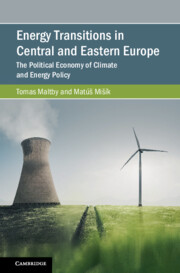Book contents
- Energy Transitions in Central and Eastern Europe
- Cambridge Studies on Environment, Energy and Natural Resources Governance
- Energy Transitions in Central and Eastern Europe
- Copyright page
- Dedication
- Contents
- Figures
- Tables
- Preface
- Acknowledgements
- Abbreviations
- Introduction
- 1 The Development of Energy and Climate Policy in the EU and CEE
- 2 A Conceptual Framework for Understanding Energy Transitions
- 3 Energy Governance
- 4 The Effect of Foreign Policy on Climate and Energy Policy
- 5 State-Society Relations
- 6 The Influence of CEE Countries on EU Climate and Energy Policy
- 7 The Global Context
- 8 Conclusion
- Bibliography
- Index
Introduction
Published online by Cambridge University Press: 19 April 2024
- Energy Transitions in Central and Eastern Europe
- Cambridge Studies on Environment, Energy and Natural Resources Governance
- Energy Transitions in Central and Eastern Europe
- Copyright page
- Dedication
- Contents
- Figures
- Tables
- Preface
- Acknowledgements
- Abbreviations
- Introduction
- 1 The Development of Energy and Climate Policy in the EU and CEE
- 2 A Conceptual Framework for Understanding Energy Transitions
- 3 Energy Governance
- 4 The Effect of Foreign Policy on Climate and Energy Policy
- 5 State-Society Relations
- 6 The Influence of CEE Countries on EU Climate and Energy Policy
- 7 The Global Context
- 8 Conclusion
- Bibliography
- Index
Summary
This book explores how the EU has attempted to balance its energy security objectives in the twenty-first century, to achieve security of supply, reasonable prices and ambitious climate goals. Specifically, the book focuses on how these challenges have played out in Central and Eastern Europe in the context of their accession to the EU, as members are both subject to and shape the EU’s agenda and legislative outputs. Here we introduce how general prioritisation of security of supply concerns has constrained and at times enabled energy transitions in the region, and how a consistent concern with import dependence on Russia was discursively adopted by the wider EU in the late 2000s, and as a policy goal from 2022. The introduction presents two main arguments of the book (priority of energy security of the CEE countries over climate goals and heterogeneity of the region) and its research design.
Keywords
- Type
- Chapter
- Information
- Energy Transitions in Central and Eastern EuropeThe Political Economy of Climate and Energy Policy, pp. 1 - 12Publisher: Cambridge University PressPrint publication year: 2024

